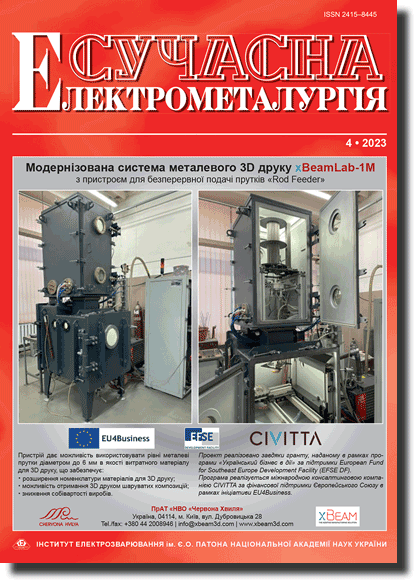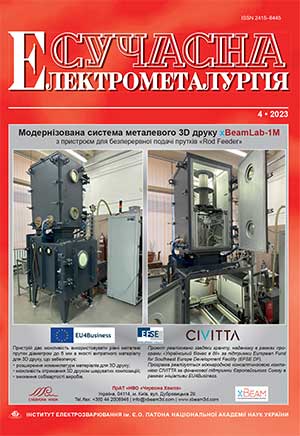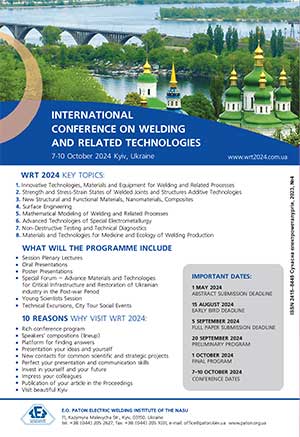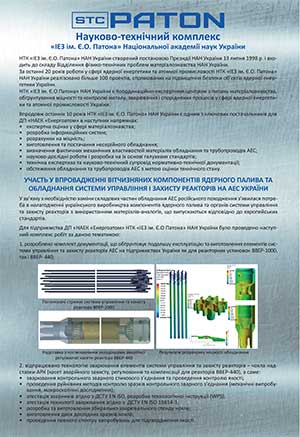Доступ для скачування ПДФ файлів журналів для підписників та рецензентів наукометричних баз.
Організація: Elsevier for content access(ПДФ файли журналів виданих раніше 2024 року відкриті для завантаження))
Організація: Elsevier for content access(ПДФ файли журналів виданих раніше 2024 року відкриті для завантаження))
| 2023 №04 (05) |
DOI of Article 10.37434/sem2023.04.06 |
2023 №04 (07) |
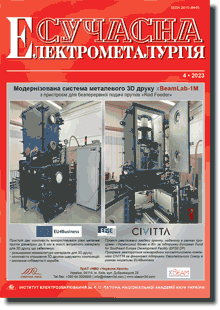
Сучасна електрометалургія, 2023, #4, 44-53 pages
Механічні характеристики зварних з’єднань високоміцних титанових сплавів, отриманих різними способами зварювання
С.В. Ахонін1, В.Ю. Білоус1, Р.В. Селін1, Е.Л. Вржижевський1, С.Л. Антонюк2
1ІЕЗ ім. Є.О. Патона НАН України. 03150, м. Київ, вул. Казимира Малевича, 11. E-mail: office@paton.kiev.ua2ДП «АНТ К ім. О.К. Антонова». 03062, м. Київ, вул. Академіка Туполєва, 1. E-mail: info@antonov.com
Реферат
Досліджено властивості зварних з’єднань титанових псевдо-β-сплавів ВТ 19 і Ti–2,8Al–5,1Mo–4,9Fe та складнолегованого титанового (α+β)-сплаву Т120, отриманих електронно-променевим і аргонодуговим зварюванням та після декількох видів термічної обробки (відпал, регламентований відпал, гартування у воду, уповільнене охолодження). Перевагою технології електронно-променевого зварювання титану і сплавів на його основі крім забезпечення надійного захисту зварних з’єднань є можливість здійснення локального підігріву і подальшої термічної обробки у вакуумній камері. З метою порівняння властивостей зварних з’єднань в стані після зварювання та додаткової термообробки було запропоновано критерій якості. Встановлено, що виконання електронно-променевого зварювання з використанням локальної термічної обробки та попереднього підігріву, а також виконання з’єднань аргонодуговим зварюванням з вжитком присадного матеріалу, що дозволяє знизити на 10…20 % кількість легуючих елементів в металі шва порівняно з основним металом, забезпечує високу якість зварних з’єднань високоміцних титанових псевдо-β-сплавів в стані після зварювання. Бібліогр. 19, табл. 7, рис. 5.
Ключові слова:: титан, титанові сплави, двофазні, (α+β)-, економнолеговані, псевдо-β-, зварні з’єднання, термічна обробка, відпал, гартування, старіння, мікроструктура, механічні властивості
Received 02.10.2023
Список літератури
1. Boyer, R.R., Williams, J.C. (2011) Developments in research and applications in the titanium industry in the USA. Proc. of 12th World Conf. on Titanium, I, 10–19.2. (2013) Titanium Metal: Market Outlook to 2018. 6th Ed. Roskill Information Services Ltd, USA.
3. Dobrescu, M., Dimitriu, S., Vasilescu, M. (2011) Studies on Ti–Al–Fe low-cost titanium alloys manufacturing, processing and applications. Metalurgia Int., 16(4), 73.
4. Boyer, R.R., Briggs, R.D. (2005) The use of β titanium alloys in the aerospace industry. J. Mater. Eng. and Performance, 14(6), 681−685.
5. Cotton, J.D., Briggs, R.D., Boyer, R.R. et al. (2015) State of the art in beta titanium alloys for airframe applications. JOM, 67(6), 1281–1303.
6. Liu, H., Wang, Haomin, Zhang, Zhen et al. (2019) Enhancing the mechanical properties of electron beam welded TC17 titanium alloy joint by post-weld heat treatment. J. of Alloys and Compounds, 810, 151−937.
7. Bolzoni, Leandro, Elisa María Ruiz-Navas, Elena Gordo (2017) Quantifying the properties of low-cost powder metallurgy titanium alloys. Materials Sci. and Eng.: A, 687, 47−53.
8. Kaur, M., Singh, K. (2019) Review on titanium and titanium based alloys as biomaterials for orthopedic applications. Materials Sci. and Eng.: C, 102, 844−862.
9. Froes, F.H. (2015) Titanium physical metallurgy processing and applications. USA, ASM Int., 265–269.
10. Weiping, F., Xiao, T, Zhang, Y.P. et al. (2019) Stress corrosion crack sensitivity of ultra-thick TC4 titanium alloy electron beam welding joints. Transact. of the China Welding Institution, 40, 121–8.
11. Tang, B., Kou, H., Zhang, X. et al. (2016) Study on the formation mechanism of α lamellae in a near β titanium alloy. Prog. Nat. Sci. Mater. Int., 26, 385–390. DOI: https://doi. org/10.1016/J.PNSC.2016.06.009
12. Fan, J.K., Kou, H.C., Lai, M.J. et al. (2013) Hot deformation mechanism and microstructure evolution of a new near β-titanium alloy. Materials Sci. and Eng. A, 584, 121–132.
13. Moiseev, V.N., Kulikov, R.F., Kirillov, Yu.G. et al. (1979) Welded joints of titanium alloys. Moscow, Metallurgiya [in Russian].
14. Khorev, A.I. (2012) Titanium superalloy VT19. Tekhnologiya Mashinostroeniya, 6, 2−5 [in Russian].
15. Akhonin, S.V., Severin, A.Yu., Belous, V.Yu. et al. (2017) Structure and properties of titanium alloy VT19, produced by the electron beam melting, after thermomechanical treatment. Sovrem. Elektrometall., 3, 19–24 [in Russian]. DOI: https://doi.org/10.15407/sem2017.03.04
16. Li, Y., Wang, H., Han, K. et al. (2017). Microstructure of Ti−45Al−8.5 Nb-0.2 W-0.03 Y electron beam welding joints. J. Mater. Proc. Technol., 250, 401−409.
17. Liu, P., Zhang, G.M., Zhai, T., Feng, K.Y. (2017) Effect of treatment in weld surface on fatigue and fracture behavior of titanium alloys welded joints by vacuum electron beam welding. Vacuum, 141, 176–180.
18. Akhonin, S.V., Bilous, V.Yu., Selin, R.V., Petrichenko, I.K. (2020) Heat treatment of high-strength pseudo-β-titanium alloy produced by EBM process and of its welded joints. Suchasna Elektrometal., 1, 14–25 [in Ukrainian]. DOI: https://doi.org/10.37434/sem2020.01.02
19. Akhnonin, S.V., Bilous, V.Yu., Selin, R.V. et al. (2021) Influence of heat treatment on the structure and properties of welded joints of high-strength titanium alloys based on β-phase. Suchasna Elektrometal., 4, 51−58 [in Ukrainian]. DOI: https://doi.org/10.37434/sem2021.04.08
Реклама в цьому номері:
Вартість передплати/замовлення на журнали або окремі статті
| журнал/валюта | річний комплект друкований |
1 прим. друкований |
1 прим. електронний |
одна стаття (pdf) |
| AS/UAH | 1800 грн. | 300 грн. | 300 грн. | 150 грн. |
| AS/USD | 192 $ | 32 $ | 26 $ | 13 $ |
| AS/EUR | 180 € | 30 € | 25 € | 12 € |
| TPWJ/UAH | 7200 грн. | 600 грн. | 600 грн. | 280 грн. |
| TPWJ/USD | 384 $ | 32 $ | 26 $ | 13 $ |
| TPWJ/EUR | 348 € | 29 € | 24 € | 12 € |
| SEM/UAH | 1200 грн. | 300 грн. | 300 грн. | 150 грн. |
| SEM/USD | 128 $ | 32 $ | 26 $ | 13 $ |
| SEM/EUR | 120 € | 30 € | 25 € | 12 € |
| TDNK/UAH | 1200 грн. | 300 грн. | 300 грн. | 150 грн. |
| TDNK/USD | 128 $ | 32 $ | 26 $ | 13 $ |
| TDNK/EUR | 120 € | 30 € | 25 € | 12 € |
AS = «Автоматичне зварювання» - 6 накладів на рік;
TPWJ = «PATON WELDING JOURNAL» - 12 накладів на рік;
SEM = «Сучасна електрометалургія» - 4 наклада на рік;
TDNK = «Технічна діагностика та неруйнівний контроль» - 4 наклада на рік.





